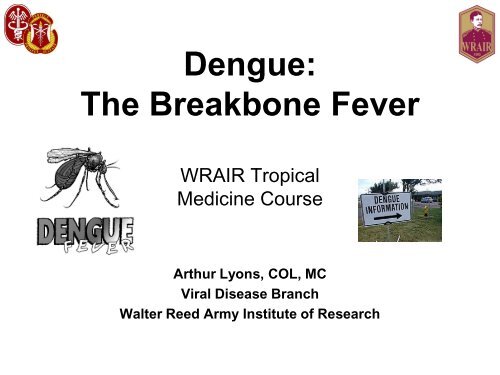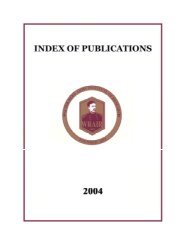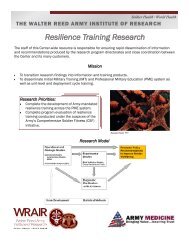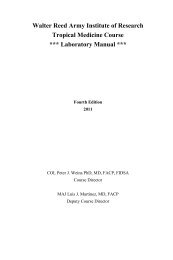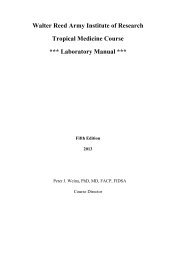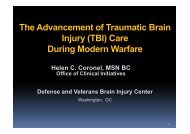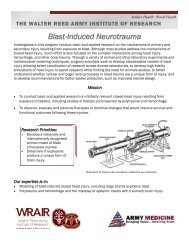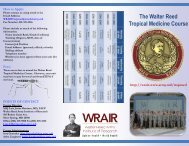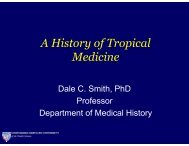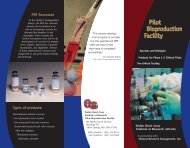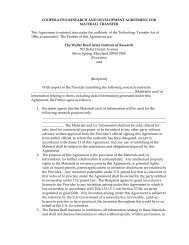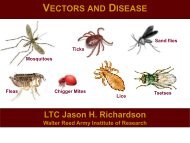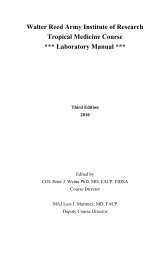Dengue: The Breakbone Fever - Walter Reed Army Institute of ...
Dengue: The Breakbone Fever - Walter Reed Army Institute of ...
Dengue: The Breakbone Fever - Walter Reed Army Institute of ...
You also want an ePaper? Increase the reach of your titles
YUMPU automatically turns print PDFs into web optimized ePapers that Google loves.
<strong>Dengue</strong>:<br />
<strong>The</strong> <strong>Breakbone</strong> <strong>Fever</strong><br />
WRAIR Tropical<br />
Medicine Course<br />
Arthur Lyons, COL, MC<br />
Viral Disease Branch<br />
<strong>Walter</strong> <strong>Reed</strong> <strong>Army</strong> <strong>Institute</strong> <strong>of</strong> Research
NOT the Band
Disclaimer<br />
• <strong>The</strong> points made in this presentation are<br />
solely the views/opinions <strong>of</strong> the author and<br />
do not reflect the views/opinions <strong>of</strong> the US<br />
Government, US Department <strong>of</strong> Defense,<br />
US <strong>Army</strong> or the US <strong>Army</strong> Medical<br />
Research and Materiel Command.
Take Home Points<br />
• Mosquito-borne illness<br />
– Not spread person-to-person<br />
• First infection can be a bad experience<br />
• Second infection can be deadly<br />
• No antiviral treatment<br />
• No vaccine (yet)
Case (1)<br />
• 25 y/o male Indiana Jones type presents to your clinic in June @ Ft. Bragg, NC with<br />
c/o headache, abdominal pain, nausea and vomiting for the past 24 hours. Took<br />
pepto bismol and tylenol without relief.<br />
• He returned from leave OCONUS 2 days ago (SubSaharan Africa , Latin America<br />
and SE Asia) where he swam in the ocean, ate adventurously, suffered numerous<br />
different insect bites, partook <strong>of</strong> some “horizontal refreshment” with local talent, and<br />
volunteered to be a cow herder for 2 weeks in the Pampas. He has 2 cats, a dog,<br />
tropical fish and several ferrets as pets at home. 3 weeks ago he cleaned out his<br />
aquarium, and stated it was a “bloody chore”. He did not take appropriate<br />
prophylaxis prior to/during the trip.<br />
• What do you do?<br />
• A) Bellyache, GOMER, discharge<br />
• B) Give him extra-strength PB and discharge with instruction to f/u with primary HCP<br />
next week,<br />
• C) Admit, evaluate for, among other things, malaria, dengue and RMSF<br />
• D) Consult psychiatry
Introduction to <strong>Dengue</strong><br />
• Definition: Mosquito-borne flaviviral<br />
disease.<br />
• Etiology:<br />
Infection with one <strong>of</strong> four types <strong>of</strong><br />
dengue virus:<br />
– DEN-1<br />
– DEN-2<br />
– DEN-3<br />
– DEN-4<br />
• Transmission:<br />
– Vector: Aedes mosquito<br />
• Aedes aegypti<br />
• Aedes albopictus<br />
– Blood transfusion<br />
– Organ transplantation<br />
– No person-to-person transmission<br />
documented
History <strong>of</strong> <strong>Dengue</strong><br />
• Clinical descriptions date as far back as 992<br />
AD in China<br />
• David Bylon (Batvia) in 1779<br />
– “knokkelkoorts” – joint fever<br />
• Benjamin Rush<br />
– Termed “breakbone fever”<br />
– Comes from Swahili “ka dinga pepo”<br />
meaning a sudden cramp like seizure<br />
and plague<br />
Thomas S, Advances in Virus Research 2003.<br />
Kyle J Annu Rev Microbiol 2008. 62:71-92.<br />
http://www91.homepage.villanova.edu/eli.greenbaum/peru.htm
History <strong>of</strong> <strong>Dengue</strong> (2)<br />
• Viral etiology suggested in early 1900’s by<br />
Ashburn and Craig<br />
• Virus types 1 and 2 isolated during World<br />
War II<br />
• 1956 outbreak in Manila led to identification<br />
<strong>of</strong> Den-3 and DEN-4<br />
• <strong>Dengue</strong> hemorrhagic fever recognized since<br />
1950’s<br />
Thomas S Advances in Virus Research 2003.<br />
Kyle J Annu Rev Microbiol 2008. 62:71-92.
<strong>Dengue</strong> Virus<br />
• Flavivirus (single-stranded RNA virus)<br />
• Spherical, 40-50 nm (dia.) viral particle<br />
– 3 Structural (E, C, M) proteins<br />
– 7 Nonstructural (NS1, NS2A, NS2B, NS3,<br />
NS4A, NS4B, NS5)<br />
• 4 serotypes<br />
– DENV 1 through 4<br />
– Multiple genotypes per serotype<br />
• Common progenitor 1,000 years ago<br />
• Serotypes have further divergence<br />
– 62 to 67% homology based on amino acid sequence<br />
• Varying pathogenicity based on serotype
Case 2<br />
• 50 y/o man with multiple mosquito bites<br />
after exploring the Amazon during a recent<br />
(2 weeks ago) trip. Had been recently<br />
web surfing and found out about dengue.<br />
He asks you if he should take prophylaxis<br />
against dengue. He has been<br />
asymptomatic. What do you do?<br />
• A) Admit, put on ribavirin<br />
• B) Reassure
Vector<br />
• Aedes aegypti and Ae. albopticus<br />
– Highly susceptible to dengue<br />
• Efficient vectors<br />
– Prefers human blood<br />
– Daytime feeder: interrupted, between egg<br />
laying<br />
• 0800-1300; 1500-1700<br />
– Bite goes unnoticed<br />
– Multiple bites per blood meal; one<br />
mosquito can infect several persons<br />
– Adapted to urban life; breeds in freshwater<br />
containers<br />
• RAPID TRANSMISSION, EXPLOSIVE EPIDEMICS<br />
• Rapid<br />
Aedes<br />
aegypti
Larvae<br />
A water sample is teeming with mosquito larvae<br />
after it was collected from a fountain outside a<br />
vacant house July 15 in Miami Beach, Fla.<br />
Miami-Dade County health <strong>of</strong>ficials are reporting<br />
the first suspected local case <strong>of</strong> dengue fever, a<br />
potentially serious mosquito-borne illness that<br />
had once disappeared from the United States.<br />
http://www.usatoday.com/news/health/2010-08-03-dengue-fever_N.htm
http://www.centromedico.com.uy/Novedades/dengue.htm<br />
Life Cycle
Habitat<br />
• Breeds in clean, still,<br />
stagnant water<br />
– Discarded tires<br />
– Water tanks<br />
– Storage appliances<br />
http://www.fcen.uba.ar/habitat/dengue.htm
Breeding sites
<strong>Dengue</strong>: Epidemiology<br />
Assessment<br />
• Leading arboviral (mosquito-borne) infection<br />
• Major health problem in the subtropics and tropics (~35 o N and ~35 o S)<br />
– Southeast Asia, India, Middle East, Caribbean, Central and South<br />
America, Australia, South and Central Pacific<br />
– Transmission in ~ 100 countries<br />
– Recent suspected dengue outbreaks in<br />
Yemen, Pakistan, Saudi Arabia,<br />
Madagascar,<br />
Sudan, Cape Verde
Epidemiology Assessment (2)<br />
• 2.5 billion people at risk for infection<br />
• 50-100 million infections annually<br />
• ~500,000 cases <strong>of</strong> DHF annually<br />
• Up to 25,000 deaths annually<br />
• Significant Economic Burden<br />
– SE Asia: 1,300 disability-adjusted life years<br />
– Similar to TB, other childhood and tropical diseases
World distribution <strong>of</strong> dengue viruses and their<br />
mosquito vector, Aedes aegypti, in 2005<br />
<strong>The</strong> tropical zone <strong>of</strong> the world between 350N and 350S latitude and area not over 1,000 ft.<br />
above sea level is the usual habitat, the areas are marked by monsoon-rains.
http://www.cdc.gov.
Total <strong>Dengue</strong> Cases and Deaths, 2003-2008<br />
Source: <strong>Dengue</strong>Net
<strong>The</strong> Global Resurgence <strong>of</strong><br />
<strong>Dengue</strong><br />
• Unprecedented global population growth<br />
• Unplanned and uncontrolled urbanization<br />
• Lack <strong>of</strong> effective mosquito vector control<br />
• Globalization <strong>of</strong> trade<br />
• More man-made breeding grounds (waste)<br />
• Increased international air travel<br />
• Decay in public health infrastructure<br />
Aedes aegypti in the Americas (1970), at the end <strong>of</strong><br />
the mosquito eradication program, & in 2002
Air Traffic Global Flight Patterns
Departamento de Salud Secretaría Auxiliar de Salud Ambiental<br />
Programa de Higienización del Ambiente Físico Inmediato<br />
Directora: Dra. Cano<br />
Casos Sospechosos de <strong>Dengue</strong> Semanal, Año 2010<br />
1 97 97 27 516 5,808<br />
2 172 269 28 495 6,303<br />
3 151 420 29 789 7,092<br />
4 135 555 30 734 7,826<br />
5 168 723 31 662 8,488<br />
6 193 916 32 887 9,375<br />
7 192 1,108 33 1,053 10,428<br />
8 180 1,288 34 928 11,356<br />
9 244 1,532 35<br />
10 193 1,725 36<br />
11 178 1,903 37<br />
12 173 2,076 38<br />
13 192 2,268 39<br />
14 198 2,466 40<br />
15 218 2,684 41<br />
16 151 2,835 42<br />
17 156 2,991 43<br />
18 172 3,163 44<br />
19 156 3,319 45<br />
20 176 3,495 46<br />
21 192 3,687 47<br />
22 235 3,922 48<br />
23 242 4,164 49<br />
24 330 4,494 50<br />
25 384 4,878 51<br />
26 414 5,292 52
<strong>Dengue</strong> in the USA<br />
• Some historical dengue outbreaks in the USA<br />
– 1780: Philadelphia, PA<br />
– 1826-8: Savannah, GA<br />
– 1850-1: Charleston, SC, Savannah, GA, New<br />
Orleans, LA, Mobile, AL, Galveston, TX, Augusta, GA<br />
– 1922: Texas, Savannah, GA<br />
– 1934: Florida<br />
– 1945: New Orleans<br />
http://www.topnews.in/number-dengue-cases-delhi-reaches-913-2238269
<strong>Dengue</strong> in the USA (2)<br />
• Recent indigenous transmission<br />
– Texas:<br />
• 1980: 23 cases, first locally acquired since 1945<br />
• 1980-1999: 64 cases (lab-documented)<br />
• 2005: DEN-2 epidemic in Brownsville; estimated incidence <strong>of</strong><br />
recent dengue infection (4% <strong>of</strong> population)<br />
– Hawaii:<br />
• 2001-2002: 122 cases (first since 1944)<br />
– Florida (Key West):<br />
• 2009-2011: 93 cases (as <strong>of</strong> 17 May 2011)<br />
• 6 cases to date in 2011: Miami-Dade (2), Palm beach (2),<br />
Martin (1), Hillsborough (1) 1 Counties<br />
1<br />
Anil L, Stanek D, Blackmore C, Stark L, Mock V.<br />
http://www.doh.state.fl.us/Environment/medicine/arboviral/pdfs/2011/2011Week42ArbovirusReport_10-22-2011.pdf
It is here!<br />
<strong>Dengue</strong> fever outbreak feared in Key West [Updated]<br />
July 14, 2010|By Thomas H. Maugh II, Los Angeles Times<br />
Federal <strong>of</strong>ficials said Tuesday that they fear an outbreak <strong>of</strong> dengue fever in Florida after a<br />
survey <strong>of</strong> Key West residents found that at least 5% had been infected or exposed to the<br />
virus. With the exception <strong>of</strong> a handful <strong>of</strong> isolated cases along the Texas-Mexico border,<br />
there had previously been no cases in the continental United States since 1946 and no<br />
outbreak in Florida since 1934.<br />
5% <strong>of</strong> Key West Population Infected in 2009;<br />
New Case Suggests Ongoing Outbreak<br />
By Daniel J. DeNoon<br />
WebMD Health News<br />
Reviewed by Laura J. Martin, MD<br />
May 20, 2010 - An "extended outbreak" <strong>of</strong> dengue fever is ongoing in Key West, Fla., where some 5% <strong>of</strong> residents were infected last fall.<br />
<strong>The</strong> latest case <strong>of</strong> the mosquito-borne disease was in mid-April. It's not yet clear whether the April case is a continuation <strong>of</strong> the 2009 outbreak or a new outbreak from a different dengue strain.<br />
Although only 28 cases have been definitively identified, blood tests conducted in September 2009 detected evidence <strong>of</strong> recent infection in 5.4% <strong>of</strong> 240 randomly selected residents.<br />
"<strong>The</strong> best estimate from the survey is that about 5% <strong>of</strong> the population <strong>of</strong> Key West was infected in 2009 with dengue," dengue expert Christopher J. Gregory, MD, <strong>of</strong> the CDC's Epidemic Intelligence Service, tells WebMD.
Key West <strong>Dengue</strong><br />
• RT-PCR done on 1,178 pools <strong>of</strong> Ae. aegypti<br />
mosquitoes collected from Monroe County, FL<br />
from 27 January-17 December 2010<br />
• DENV-1<br />
• KW sequence grouped as a member <strong>of</strong> a large<br />
clade <strong>of</strong> recent DV from Central America<br />
– Nicaragua, 2006, 2008<br />
• Unknown time <strong>of</strong> introduction into FL<br />
Graham AS, Pruszynski CA, Hribar LJ et al., 2011. Emerging Infectious Diseases • www.cdc.gov/eid • Vol. 17, No. 11, November 2011
<strong>Dengue</strong> Impact on U.S. Military<br />
Operations<br />
• Philippines<br />
• World War II<br />
• Vietnam<br />
Hospitalized US military personnel, Philippines
<strong>Dengue</strong> Impact on recent<br />
U.S. Military Operations<br />
• Somalia<br />
– Operation Restore Hope (1993)<br />
– 58/289 (20%) hospitalized febrile troops had<br />
laboratory-confirmed DF<br />
– 69/289 (24%) suspected DF cases<br />
• Haiti<br />
– Operation Uphold Democracy (1994)<br />
– 31/103 (30%) hospitalized febrile troops had DF<br />
• Defense Medical Surveillance System (DMSS)<br />
– 1997-2006: 26 DF cases hospitalized, 170<br />
ambulatory
USASOC Study<br />
• Seroprevalence study<br />
• USASOC personnel deployed to dengueendemic<br />
areas in Latin America<br />
– At least 30 days, from 2006-2008<br />
– 500 specimens<br />
– DoD Serum Repository<br />
– Sandwich ELISA<br />
• 11.0% seroprevalence rate<br />
Caci JB, Lyons AG, Tack DM; ASTMH Abstract # 90, 2010
Pathogenesis<br />
• Multiple theories regarding pathogenesis but none<br />
accepted<br />
• Lack <strong>of</strong> a reliable animal model<br />
• Complicated host and viral interactions<br />
– Different responses in adults and infants<br />
• Antibody dependent viral enhancement<br />
– Upregulation <strong>of</strong> infection<br />
– Increased cytokine activity<br />
• Unknown etiology <strong>of</strong> capillary leak syndrome<br />
characterized by DSS
Pathogenesis (2)<br />
• No evidence <strong>of</strong> direct viral infection <strong>of</strong><br />
endothelial cells 1<br />
• Transient disruption in the function <strong>of</strong> the<br />
endothelial glycocalyx layer<br />
– A molecular sieve<br />
– Hypoalbuminemia, proteinuria<br />
– DENV and NS1 adhere to heparan sulfate<br />
– Increased urinary heparan sulfate excretion<br />
seen in kids with severe dengue 2<br />
1<br />
Leong AS et al. Semin Diagn Pathol 2007;24:227-36<br />
2<br />
Avirutnan P et al. PLoS Pathog 2007;3(11):e183.
Clinical Manifestations<br />
<strong>Dengue</strong> Shock<br />
Syndrome<br />
<strong>Dengue</strong><br />
Hemorrhagic<br />
<strong>Fever</strong><br />
50 to 90% <strong>of</strong> cases<br />
DEN-2 and DEN-4<br />
Kyle J Annu Rev Microbiol 2008. 62:71-92.
Clinical <strong>Dengue</strong><br />
– Spectrum <strong>of</strong> clinical illness<br />
• Primarily defined in Thai cohorts<br />
• Asymptomatic infection 50%<br />
• Undifferentiated fever<br />
• <strong>Dengue</strong> fever<br />
45%<br />
• <strong>Dengue</strong> hemorrhagic fever (DHF)/ <strong>Dengue</strong><br />
shock syndrome (DSS)<br />
Old Classification <strong>of</strong> <strong>Dengue</strong><br />
http://lukemaciel.deviantart.com/art/Mosquito-da-<strong>Dengue</strong>-87552543
Old Definition <strong>of</strong> <strong>Dengue</strong><br />
Hemorrhagic <strong>Fever</strong><br />
• <strong>Fever</strong> lasting 2-7 days<br />
• Tendency to hemorrhage<br />
– Positive tourniquet test (TT)<br />
– Spontaneous bleeding<br />
• Platelet count
New Classification<br />
• <strong>Dengue</strong> <strong>Fever</strong> (DF)<br />
– Classical DF, recovers without major<br />
sequelae<br />
• Severe <strong>Dengue</strong><br />
– Plasma leakage resulting in shock<br />
– Accumulation <strong>of</strong> serosal fluid<br />
– Severe bleeding<br />
– Severe organ impairment<br />
<strong>Dengue</strong>: Guidelines for Treatment, Prevention and Control. Geneva, WHO, 2009
Most <strong>Dengue</strong> infections<br />
are…<br />
• Asymptomatic, or<br />
• Mild symptomatic illness<br />
–Undifferentiated fever<br />
–+/- Rash
<strong>Dengue</strong> <strong>Fever</strong> (DF)<br />
• Incubation period 3-7 days, illness<br />
lasts ~7 days<br />
• A range <strong>of</strong> clinical manifestations<br />
•Three phases<br />
•Febrile<br />
•Critical<br />
•Recovery<br />
• Epi: Travel/residence in<br />
urban areas <strong>of</strong> tropics/sub-tropics<br />
http://pr<strong>of</strong>essoralilianbiologia.blogspot.com/2008/04/lilian-cia.html
DF (Day 1, Febrile Phase)<br />
• Abrupt onset high fever (≥38.5 o C)<br />
– 5-7 days fever (biphasic)<br />
• Rash<br />
– Early flushlike rash may be replaced by a<br />
macular/morbilliform rash. Late petechiae<br />
• Chills, vomiting<br />
• Arthralgias, myalgias<br />
• Severe headache<br />
• Eye, Retro-orbital pain<br />
• Lumbosacral pain<br />
http://www.cartunista.com.br/romario_dengue.html
DF (Day 2, Febrile Phase)<br />
– Severe muscle, joint pain<br />
– Nausea, vomiting<br />
– Lassitude, prostration<br />
– Respiratory symptoms<br />
– Epistaxis, gum bleeding, petechiae<br />
• Classic DF with some hemorrhage is NOT DHF<br />
– PE:<br />
• <strong>Fever</strong><br />
• Generalized rash (may be replaced by macular/morbilliform later<br />
on). Petechial late<br />
• Relative bradycardia<br />
• Generalized lymphadenopathy<br />
• Petechial hemorrhages<br />
– After 3-7 days, no sequelae
Rash<br />
http://www.itg.be/itg/DistanceLearning/LectureNotesVandenEndenE/imagehtml/ppages/CD_1038_061c.htm. Used with permission
Case 3<br />
• 27 y/o AD USMC from Puerto Rico<br />
presented with 2 days <strong>of</strong> increasing fever<br />
(>38.5 C), severe headache, rash,<br />
arthralgias, myalgias, while on deployment<br />
in the Philippines. After 5 days <strong>of</strong> illness,<br />
his fever suddenly resolved. Should you:<br />
• 1) Discharge<br />
• 2) Draw labs and observe
Symptomatic <strong>Dengue</strong> Clinical<br />
Syndromes<br />
<strong>Dengue</strong> <strong>Fever</strong><br />
(DF)<br />
<strong>Dengue</strong><br />
Hemorrhagic<br />
<strong>Fever</strong> (DHF)<br />
<strong>Dengue</strong> Shock<br />
Syndrome<br />
(DSS)
Critical Phase<br />
• Small proportion <strong>of</strong> patients<br />
– Children, young adults<br />
• Occurs at time <strong>of</strong> defervescence<br />
– Around days 4-7 <strong>of</strong> illness<br />
• Systemic vascular leak syndrome<br />
– Increasing hematocrit<br />
– Hypoproteinemia<br />
– Pleural effusions<br />
– Ascites
Severe <strong>Dengue</strong><br />
• Severe plasma leakage<br />
– Shock (DSS)<br />
– Serosal fluid accumulation with respiratory distress<br />
• Severe bleeding<br />
– Clinically evident<br />
• Multi-organ involvement<br />
– Liver: AST/ALT >1000<br />
– CNS: Impaired consciousness, seizures,<br />
encephalopathy<br />
– CV and other
http://www.pattayagogos.com/news08a.htm<br />
http://denguehemorrhagicfever.tumblr.com/<br />
DHF
<strong>Dengue</strong> Hemorrhagic <strong>Fever</strong><br />
(DHF)<br />
• Onset as per classical dengue<br />
• Damage to blood and lymph vessels<br />
• Defervescence followed (2-5 days) by<br />
– Ascites, abdominal pain<br />
– Pleural effusion<br />
– Hemorrhagic manifestations (gum bleeding, phlebotomy bleeding)<br />
which may progress to shock<br />
– Central cyanosis<br />
– Diaphoresis<br />
• Epi: Exposure in dengue endemic region with possible previous<br />
dengue infection
• PE:<br />
– Restlessness<br />
– Abdominal pain<br />
– Hemorrhage<br />
• Petechiae<br />
• Spontaneous ecchymoses<br />
DHF (2)<br />
• Bleeding: GI, GU, phlebotomy<br />
– Tender hepatomegally (75%), splenomegally<br />
– Pleural* effusions (80%) perirenal effusions (77%), hepatic,<br />
splenic, pericardial, peritoneal effusions* (variable%)<br />
– Shock<br />
• Rapid, weak pulse<br />
• Pulse pressure
Lab<br />
• Positive tourniquet test (or hemorrhagic manifestations)<br />
• Thrombocytopenia (20%)*<br />
– Pleural effusion/ascites<br />
– Petechiae<br />
• Hepatorenal shutdown with shock<br />
• Viral isolation from acute serum<br />
• Convalescent IgM (+)<br />
• Peak proteinuria**<br />
– 0.56 v. 0.08 g/d (P
<strong>Dengue</strong> Shock Syndrome<br />
(DSS)<br />
• Fluid leak outside <strong>of</strong> blood vessels<br />
• Lasts 1-2 days<br />
• Massive hemorrhage<br />
• Shock, peripheral vascular collapse<br />
– Hypoperfusion c/b myocardial dysfunction: metabolic acidosis<br />
and MOF<br />
• Cyanosis, massive pleural effusions, ascites<br />
• Narrowing pulse pressures (
Subcutaneous<br />
hemorrhage in DHF<br />
http://www.orble.com/aia/
Risk Factors for DHF/DSS<br />
• Pre-existing immunity from previous infection (heterogenous subtype)<br />
• Diabetics, asthmatics, other chronic diseases<br />
• DENV type<br />
– DENV-1,3 > 2,4<br />
• Increased time between infections<br />
• Under age 15<br />
– Increased capillary fragility<br />
• HLA type and race*<br />
– Caucasian>AA<br />
– HLA Class-1 alleles<br />
• Female sex<br />
• AB blood group<br />
• Promotor variant <strong>of</strong> DC-SIGN receptor<br />
• Single-nucleotide polymorphism in TNF gene<br />
*De la C Sierra B, Kouri G, Guzman MG. Arch. Virol., 2007, 152(3) 533-42. Epub 2006 Nov. 16.
Factors that reduce the risk <strong>of</strong><br />
severe dengue<br />
• Race<br />
• Second or third degree malnutrition<br />
• Polymorphisms in the Fc-gamma and<br />
Vitamin D receptor genes
Criteria For <strong>Dengue</strong> +/-<br />
• Probable case:<br />
Warning Signs<br />
– Resident/travel to dengue endemic area and<br />
2 <strong>of</strong> the following:<br />
– Nausea, vomiting<br />
– Rash<br />
– Aches and pains<br />
– + TT<br />
– Leukopenia<br />
– Any warning sign
Warning Signs<br />
• Continual/increasing abdominal pain/tenderness<br />
• Persistent vomiting<br />
• Clinical fluid accumulation (serosal)<br />
• Mucosal bleeding<br />
• Lethargy, restlessness<br />
• Tender hepatomegaly (>2 cm), ascites<br />
• Lab: increase in Hct. concurrent with rapid<br />
decrease in platelets*<br />
• Sudden reduction in temperature
Recovery Phase<br />
• Altered vascular permeability syndrome<br />
resolves<br />
– After 48-72 hours<br />
• Rapid improvement in patient’s symptoms<br />
• Rash<br />
– Mild maculopapular to severe, pruritic lesions<br />
(leukocytoclastic vasculitis)<br />
– Resolves with desquamation (1-2 weeks)<br />
• Pr<strong>of</strong>ound fatigue for several weeks
Case 4<br />
• 30 y/o AD Sailor who recently returned<br />
from a TDY to Thailand 4 days ago. Has<br />
had 2 days <strong>of</strong> fever, excruciating HA, eye<br />
pain, severe myalgias, arthralgias, sweats<br />
and rash. You suspect dengue.<br />
• How to diagnose?<br />
• How to treat?
Lab<br />
• Marked leukopenia<br />
• Thrombocytopenia<br />
• Moderate elevation <strong>of</strong> AST/ALT<br />
• Viral isolation to Day 5 only<br />
• Negative malaria smears<br />
• <strong>Dengue</strong> IgM (+) on Day 6 serum<br />
– Takes 5 days to manifest<br />
• PCR available<br />
• Convalescent: 4-fold rise in IgG may be required
Lab (2)<br />
• Antibody specificity increases over time<br />
• Most readily available diagnostic tests<br />
– ELISA (serology)<br />
• Cross-reactive; not specific<br />
• MAC-ELISA, IgG ELISA<br />
• IgM/IgG (>1.2, 1.4?) not defined<br />
– PRNT, microneutralization (serology)<br />
• More specificity<br />
• Research, vaccine work<br />
– Viral Isolation<br />
• Most specific
Lab (3)<br />
• Nucleic Acid Amplification (NAAT)<br />
– RT-PCR<br />
– Real Time RT-PCR<br />
– NASBA<br />
– None commercialized to date<br />
– None standardized<br />
• Antigen Detection<br />
– NS1<br />
– Antigen capture ELISA, lateral flow antigen detection, NS1 IgM,<br />
IgG responses.<br />
– Do not differentiate between the different serotypes
Slide courtesy <strong>of</strong> Dr. Subhamoy Pal<br />
Immune Response to <strong>Dengue</strong><br />
NS-1: Effective days 1-5<br />
post onset <strong>of</strong> symptoms<br />
Acute<br />
Acute<br />
IgM/IgG: Effective after<br />
day 5<br />
Convalescent<br />
Convalescent<br />
A diagnostic capable <strong>of</strong><br />
detecting both is<br />
desirable<br />
Day 0 7
Lab (4)<br />
• Primary infection<br />
– IgM first to appear, at end <strong>of</strong> 3-5 day fever period (~50%), day 6-<br />
10 (93-99%), peak (2 weeks), undetectable by 2-3 mos.<br />
– IgG appears at end <strong>of</strong> first week <strong>of</strong> illness, persists for >year<br />
– RT-PCR can provide a same-day diagnosis with a similar<br />
sensitivity to culture<br />
• Secondary infection<br />
– IgM typically LOWER titer than primary infection; false negatives<br />
have occurred<br />
– IgG typically HIGHER titer than primary infection; may x-react<br />
with other flaviviruses (JE, YF, WN)
Criteria for Confirmed and<br />
Probable <strong>Dengue</strong> Infection<br />
• Confirmed<br />
– Viral isolation<br />
– Genome detection<br />
– Antigen detection<br />
– IgM/IgG seroconversion<br />
• Probable<br />
– IgM positive<br />
– Elevated IgG titer (> 1,280 by HAI)
http://www.cdc.gov/dengue/clinicalLab/diagnosticProcess.html<br />
Diagnosis
Tests Used for the Lab Diagnosis <strong>of</strong><br />
Primary <strong>Dengue</strong> Infection<br />
Test<br />
Diagnostic<br />
Window<br />
Sample<br />
Required<br />
Sample<br />
Storage<br />
Turnaround<br />
Time<br />
Viremia<br />
(Culture)<br />
Acute Phase 1 mL -80°C 2 weeks<br />
RT-PCR Acute Phase 140 μL Refrigerate if<br />
, -<br />
20°C<br />
1-2 days<br />
IgM ELISA<br />
Day 4 to –Day<br />
90 post<br />
infection<br />
1 mL Frozen or<br />
refrigerated<br />
1-2 days<br />
IgG ELISA Day 14 to > 1<br />
year postinfection<br />
1 mL Frozen or<br />
refrigerated<br />
1-2 days<br />
PanBio<br />
duoCassette<br />
Day 4 to Day 10 μL Refrigerate if<br />
, -<br />
20°C<br />
1-2 days<br />
Serum<br />
Neutralization<br />
(PRNT)<br />
1 week to >1<br />
year postinfection<br />
1 mL Frozen or<br />
refrigerated<br />
1 week<br />
SST or red top tube<br />
Virus isolation in cell culture and detection by IFA<br />
Used with IgG ELISA to differentiate primary from secondary infection<br />
Used with IgM ELISA to differentiate primary from secondary infection
Rapid Diagnostic Tests<br />
(RDT’s)<br />
Current RDT’s<br />
Future RDT’s<br />
Important for:<br />
• Quick diagnosis (lab results take time<br />
and require labs)<br />
• In resource-limited settings<br />
• Alerts a unit to ID threats<br />
• Helpful for triage during outbreaks<br />
• Curtail geographic spread <strong>of</strong><br />
infectious diseases<br />
• Stability operations and<br />
infrastructure building<br />
Worldwide demand for better diagnostics to<br />
manage treatment and prevention<br />
Slide courtesy <strong>of</strong> Dr. Subhamoy Pal
Current Rapid Diagnostic<br />
Technologies<br />
Agglutination<br />
Flow through<br />
Lateral Flow<br />
Slide courtesy <strong>of</strong> Dr. Subhamoy Pal<br />
Solid Phase<br />
Isothermal Nucleic Acid Tests
Product Introduction<br />
#1: IgG/IgM <strong>Dengue</strong> Duo Cassette<br />
10μL <strong>of</strong> serum, plasma, or whole<br />
blood<br />
15 minutes (time to result)<br />
Wu et. al. CDLI 2000, pp 106-109<br />
10 uL <strong>of</strong> serum<br />
1.5 hours<br />
Slide courtesy <strong>of</strong> Dr. Subhamoy Pal
Product Introduction cont'd<br />
#2: NS-1/IgG/IgM <strong>Dengue</strong> Duo<br />
Cassette<br />
120μL <strong>of</strong> serum or plasma<br />
15 minutes (time to result)<br />
Osorio et al. Virology Journal 2010, 7:361<br />
Slide courtesy <strong>of</strong> Dr. Subhamoy Pal
Ag/Ab level<br />
Ag/Ab level<br />
Standard Diagnostics <strong>Dengue</strong> Duo (NS-1) RDT<br />
NS1 Ag<br />
3 drops (110 μl) <strong>of</strong> plasma or serum<br />
for early acute phase samples (day 1 ~5)<br />
IgG/IgM Ab<br />
10 μl <strong>of</strong> plasma or serum for early convalescence<br />
phase samples (after day 5 ~ 14)<br />
IgG<br />
IgG<br />
NS1 Ag<br />
IgM<br />
NS1 Ag<br />
IgM<br />
1 2 3 5 7 10 12 Day 1 2 3 5 7 10 12<br />
Day<br />
Slide courtesy <strong>of</strong> Dr. Subhamoy Pal
Interpretation<br />
Negative<br />
Slide courtesy <strong>of</strong> Dr. Subhamoy Pal<br />
Primary<br />
Secondary
Why make a primary/secondary<br />
determination?<br />
• <strong>The</strong> majority (>90%) <strong>of</strong> DHF/DSS cases are secondary infections<br />
– One 20 year longitudinal study suggests that among all DHF/DSS<br />
cases 9% are primary and 91% are secondary (Nisalak, A., et al.,<br />
Am J Trop Med Hyg, 2003. 68(2): p. 191-202)<br />
• Overall, 2-4% <strong>of</strong> secondary infections proceed to severe dengue.<br />
Other risk factors also need to be considered (Guzman, M.G., et<br />
al.,1997. Am J Epidemiol, 2000. 152(9): p. 793-9; discussion 804)<br />
Positive predictive value <strong>of</strong><br />
secondary infection leading to<br />
DHF varies by region and<br />
attack rate.<br />
Slide courtesy <strong>of</strong> Dr. Subhamoy Pal
Commercially Available NS-1<br />
• Rapid Tests<br />
Products<br />
– Bio-Rad StripTM<br />
– SD (Focus) BIOLINE <strong>Dengue</strong> NS1 Assay<br />
– SD (Focus) BIOLINE <strong>Dengue</strong> Duo IgM/IgG/NS1<br />
Assay<br />
– Panbio <strong>Dengue</strong> Early Rapid<br />
• ELISA format<br />
– Panbio <strong>Dengue</strong> Early PanE (2 nd Generation)<br />
– SD NS-1 <strong>Dengue</strong> Ag ELISA<br />
– Bio-Rad PlateliaTM <strong>Dengue</strong> NS1 Ag<br />
(Evaluated by NMRC)<br />
Slide courtesy <strong>of</strong> Dr. Subhamoy Pal
Assay specifications<br />
Parameters SD Rapid Biorad<br />
Rapid<br />
Panbio<br />
Rapid<br />
BioRad<br />
ELISA<br />
Panbio<br />
ELISA<br />
Number <strong>of</strong> 1 2 3 5 7<br />
steps<br />
Blood EDTA-treated Plasma, Sera Plasma, Sera<br />
matrices blood,<br />
plasma, sera<br />
sera<br />
sera<br />
Assay Time 15-20<br />
minutes<br />
15-30<br />
minutes<br />
15 minutes 140<br />
minutes<br />
160<br />
minutes<br />
Volume 105 uL 50 uL 50 uL 50 uL 75 uL<br />
necessary<br />
Format Cassette Dipstick Dipstick 96-well 96-well<br />
Extra<br />
materials<br />
required<br />
No<br />
Tubes,<br />
pipette<br />
Pipette<br />
Pipette,<br />
incubator<br />
, plate<br />
reader<br />
Pipette,<br />
incubator<br />
, plate<br />
reader<br />
Storage Room Temp. 2-8°C 2-8°C 2-8°C 2-8°C<br />
Slide courtesy <strong>of</strong> Dr. Subhamoy Pal
Summary <strong>of</strong> data<br />
Panbio <strong>Dengue</strong> IgM/IgG Duo Cassette RDT<br />
- Down-selected from among several <strong>Dengue</strong> RDT’s<br />
- Meets KSA and Attributes <strong>of</strong> draft CDD<br />
- Marketed overseas with record <strong>of</strong> stability<br />
- Ideal after day 5 post-onset <strong>of</strong> symptoms<br />
SD NS-1 Cassette RDT’s developed recently<br />
- Available NS-1 RDT’s comprehensively evaluated<br />
- Meets KSA and Attributes <strong>of</strong> draft CDD<br />
- Required for early diagnosis <strong>of</strong> dengue between day 0-7<br />
post-onset <strong>of</strong> symptoms<br />
Together, the two RDT’s can enable dengue diagnosis through all<br />
stages <strong>of</strong> infection to fulfill capability gap.<br />
Slide courtesy <strong>of</strong> Dr. Subhamoy Pal
Advantages and limitations<br />
<strong>of</strong> different dengue diagnostic tests<br />
Diagnostic tests Advantages limitations<br />
Viral isolation and identification<br />
RNA detection<br />
• Confirmed infection<br />
• Specific<br />
• Identifies serotypes<br />
• Confirmed infection<br />
• Sensitive and specific<br />
• Identifies serotype and genotype<br />
• Results in 24–48 hours<br />
• Requires acute sample (0–5<br />
days post onset)<br />
• Requires expertise and<br />
appropriate facilities<br />
• Takes more than 1 week<br />
• Does not differentiate between<br />
primary and<br />
secondary infection<br />
• Expensive<br />
• Potential false-positives owing to<br />
contamination<br />
• Requires acute sample (0–5<br />
days post onset)<br />
• Requires expertise and<br />
expensive laboratory<br />
equipment<br />
• Does not differentiate between<br />
primary and<br />
secondary infection
Advantages and limitations <strong>of</strong><br />
different dengue diagnostic tests: Serology<br />
Diagnostic Tests Advantages Limitations<br />
IgM or IgG seroconversion<br />
IgM detection (single sample)<br />
• Confirmed infection<br />
• Least expensive<br />
• Easy to perform<br />
• Identifies probable dengue<br />
cases<br />
• Useful for surveillance,<br />
tracking outbreaks<br />
and monitoring effectiveness <strong>of</strong><br />
interventions<br />
• IgM levels can be low in<br />
secondary infections<br />
• Confirmation requires two or<br />
more serum samples<br />
• Can differentiate between<br />
primary and secondary<br />
infection*<br />
• IgM levels can be low in<br />
secondary infections<br />
*Primary infection: IgM-positive and IgG-negative (if samples are taken before day 8–10); secondary infection: IgG should be higher<br />
than 1,280 haemagglutination inhibition in convalescent serum.
Advantages and limitations <strong>of</strong><br />
different dengue diagnostic tests: Antigen<br />
Detection<br />
Diagnostic Test Advantages Limitations<br />
Clinical specimens (for<br />
example, using<br />
blood in an NS1 assay)<br />
Tissues from fatal cases (for<br />
immunohistochemistry,<br />
for example)<br />
• Confirmed infection<br />
• Easy to perform<br />
• Less expensive than virus<br />
isolation or RNA<br />
detection<br />
• Confirmed infection<br />
• Not as sensitive as virus<br />
isolation or RNA detection<br />
• Not as sensitive as virus<br />
isolation or RNA detection<br />
• Requires expertise in<br />
pathology
Tourniquet Test (TT)<br />
• Positive in up to 50% <strong>of</strong> patients with<br />
classical dengue and almost all with DHF<br />
• Non-specific<br />
• Procedure:<br />
– Inflate BP cuff halfway between systolic and<br />
diastolic BP for 5 minutes<br />
– Release<br />
– Count # petechiae in a quarter-sized patch<br />
below the cuff<br />
– >20 is positive
Sample Prep<br />
• Collect 2 separate red gel separator tubes (“tiger-tops”)<br />
– Gently invert 5 times<br />
– Allow blood to clot min. 30 min (vertical)<br />
– Centrifuge at full speed (1100-1399 G) for 10 min<br />
– Pipette <strong>of</strong>f serum into separate cryovials<br />
– Refrigerate or ice bath (2-8°C, ELISA/PRNT)<br />
– RT-PCR: store @ 2-8°C for up to 6 hours (immediate RNA<br />
extraction possible) otherwise, store @ -20°C for up to 14 days.<br />
Limit to one freeze-thaw cycle.<br />
– Isolation: store @ -80°C until ready for transport
Rx<br />
• Symptomatic, supportive<br />
– CAREFUL fluid management<br />
• Acetaminophen<br />
– NO Aspirin (Reye’s)<br />
• Oral Fluid Replacement<br />
– If can take PO, no complications, mentally with it<br />
• Serial monitoring <strong>of</strong> (to trigger IV therapy)<br />
– HR, BP, Skin perfusion, Urine output, Hct (>20%)<br />
• Development <strong>of</strong> any warning sign<br />
– Hospitalization, close observation<br />
– Judicious use <strong>of</strong> IV fluids on poor PO, rapidly increasing Hct.
Rx (2)<br />
• Shock<br />
– PROMPT fluid resusctiation<br />
– Isotonic crystalloid (initially)/colloid (for those presenting in pr<strong>of</strong>ound<br />
shock, no response to crystalloid) solutions<br />
– Keep to minimum required to support CV stability<br />
– Plasma, cryoprecipitates, whole blood (care to not fluid overload)<br />
– PREVENTIVE transfusions should be avoided<br />
• Desmopressin? IV gamma globulin? Steroids? Drugs (chloroquine,<br />
balapiravir, statins)? No evidence for efficacy<br />
• Beware pulmonary edema: may need PPV<br />
– DHF-DSS is the 3 rd most common cause <strong>of</strong> ARDS in hospitalized children in<br />
Malaysia
<strong>Dengue</strong><br />
Prevention<br />
• Prevention:<br />
– <strong>The</strong>re is no prophylactic drug for dengue<br />
– <strong>The</strong>re is no licensed vaccine (yet) to prevent dengue<br />
– Reduce risk by use <strong>of</strong> personal protective measures (DEET,<br />
permethrin-treated uniforms, screened windows, mosquito<br />
netting) and local vector control (eliminate breeding sites,<br />
insecticides)<br />
– New approaches to vector control<br />
• Genetically altered male mosquitoes<br />
• Embryonic introduction <strong>of</strong> wolbachia into A. aegypti
Prevention<br />
http://www.rafaela.gov.ar/es/popupDenge2.html<br />
http://wahootours.hyperboards.com/action/view_topic/topic_id/5675
And now for something<br />
completely different…<br />
• 31 y/o female recently returned from Singapore…<br />
• <strong>Fever</strong> (39.5°C), nausea, myalgias, back pain, HA,<br />
bilateral conjunctivitis, severe bilateral arthralgias<br />
(shoulders, knees, ankles, elbows, wrists, fingers).<br />
• Lab: Lymphopenia (0.6 G/L), AST 177 UI/L, ALT 116<br />
UI/L, LDH 780 UI/L, Nl Bili, CRP 64 mg/L.<br />
• Course: developed chronic distal arthritis and<br />
tenosynovitis, swelling <strong>of</strong> the joints without fluid<br />
accumulation.
Chikungunya
Summary<br />
• <strong>Dengue</strong> is a significant threat to the US military<br />
and civilian populations in endemic areas.<br />
– Recognize atypical presentations: maintain healthy<br />
suspicion<br />
– May not have high case fatality rates, but illness will<br />
significantly affect mission(s)<br />
• Vaccine development is underway and is<br />
challenging<br />
– WRAIR is a leader in developing dengue vaccines<br />
– Several candidate vaccines are in the pipeline
“Most individuals in the United States are<br />
• as Widespread little concerned dengue about a real dengue possibility fever as<br />
they were a decade ago about West Nile<br />
states) fever. That situation could change if<br />
dengue • Reemerged continues South its expansion and Central America, as one <strong>of</strong><br />
the Caribbean, world’s and most Puerto aggressive Rico reemerging<br />
• Increased outbreaks infections.”<br />
Texas and Hawaii<br />
• Increasing presence <strong>of</strong> Aedes albopictus (36<br />
• Vaccine is needed but far from being ready<br />
Morens D and Fauci A. JAMA 2008. 299:214-216.
Viral Disease Branch<br />
<strong>Walter</strong> <strong>Reed</strong> <strong>Army</strong> <strong>Institute</strong><br />
<strong>of</strong> Research<br />
Division <strong>of</strong> Viral Diseases


